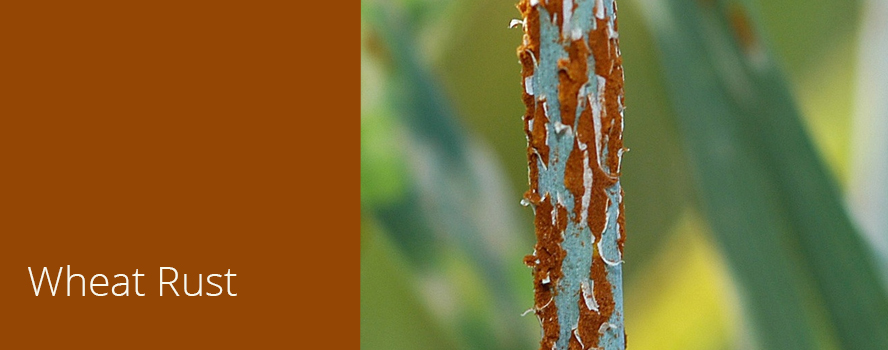Photo by Yue Jin
Wheat Rust Threatens World’s Wheat Crops
by Helga George, Ph.D.
A new strain of wheat fungus known as Ug99 that can destroy previously resistant strains of wheat is spreading throughout Africa and the Middle East.
Rust is a type of plant disease caused by fungi. Wheat rust has been a problem for wheat farmers for millennia. Controlling wheat rust was a major part of the Green Revolution of the 1960s, and genes were introduced in wheat that conferred resistance to the rust fungus. A new race of this pathogen was discovered in Africa in 1999 that could cause severe disease on previously resistant plants. This strain is known as Ug99 and threatens to spread around the world. This wheat fungus is highly virulent and has the potential to cause severe famines in countries that rely heavily on wheat as a food source. Aggressive efforts are underway to create new forms of resistance before the pathogen spreads further.
The Emergence of Wheat Rust Ug99
Rust fungi are highly specialized pathogens that require their hosts to be alive for the initial part of their infection. They use specialized feeding structures called haustoria to obtain nutrients from the plants, causing declines in yields. Wheat rust causes pustules to form on the stems of wheat and is often referred to as wheat stem rust. This fungal pathogen is known as Puccinia graminis f.sp. tritici and causes great losses of grain heads, which are often shriveled and lack starch. In many countries in the developing world, wheat is a staple crop, and the existence of strains resistant to stem rust has allowed countries such as India to flourish.
In 1999, a plant pathologist discovered wheat infected with the classic red pustules of wheat stem rust in a field in Uganda. This discovery was so unexpected that it was thought to be a transcription error. Unfortunately, the identification was correct, and this strain was named Ug99. Stem rust had evolved to overcome the resistance that had been bred into wheat cultivars during the Green Revolution of the 1960s.
This resistance was so successful that most of the world’s wheat shared the same genetic background, making them vulnerable to this new strain of stem rust. This was a potential catastrophe, since the spores of the fungus spread easily on the wind or can be transferred between countries on travelers. This disease is currently spreading in Africa and the Middle East.
Efforts to Develop Resistance to Wheat Stem Rust
There are several approaches to breeding resistance to a disease like wheat rust. There are several different types of wheat that utilize one gene for major resistance. Such cultivars are fully resistant. If a pathogen evolves the ability to overcome the resistance, however, the plants will be highly vulnerable. Another approach is to build up resistance by utilizing a greater number of genes that each contribute a small degree of resistance. A fungus is less likely to be able to overcome the effects of a number of genes at once. The latter approach is currently being utilized to combat stem rust. Plant breeding is also complicated by the need for the crop to retain desirable agronomic qualities and be appealing to the people that would grow and consume it.
This fungus is considered so dangerous that only two labs in the world are allowed to experiment with live spores. They are in very cold climates and must perform their experiments in the winter. This is in case some fungal spores escape; they will be killed by the cold. One lab is the USDA’s Cereal Disease Laboratory in St. Paul, Minnesota, in which the genome of stem rust is currently being sequenced in hopes of identifying the genes that the fungus uses to make effector proteins. These are proteins the fungus uses to perturb the plant’s resistance mechanisms. Researchers are hoping to clone these genes into bacteria and use them to screen for Ug99 resistance directly in the laboratory.
Stem Rust Could Spread Around the World
The rust fungus that causes wheat stem rust has evolved to overcome several types of major resistance genes. These genes are so effective against this severe fungal disease that they have been used in most of the world’s wheat crops for decades. Strain Ug99 was identified in 1999 in Uganda and has since been spreading throughout Africa and into the Middle East. There are several variants of this strain, which is continuously evolving.
Scientists are concerned it could spread into the breadbasket area of Pakistan. Unexpectedly, a highly virulent strain of the fungus was discovered in South Africa in the spring of 2010. Researchers are working feverishly to produce new cultivars of wheat resistant to this fungal pathogen. Wheat stem rust has the potential to cause great famines, since the spores are air-borne and can be carried by people. If it were to reach the United States, “a simple loaf of bread could become a luxury” (Koerner, from his article).
References:
Agricultural Research Service, Nov. 2, 2007, “World Wheat Supply Threatened,” ars.usda.gov, accessed May 2010
Koerner, Brendan I., Feb. 22, 2010, “Red Menace: Stop the Ug99 Fungus Before Its Spores Bring Starvation,” wired.com, accessed May 2010
QUICK LINKS TO ALL
Suite.io Articles
by Helga George, Ph.D.
AGRICULTURAL SCIENCE
• Polyphenol Oxidase Enzymes Cause Browning of Fruits and Vegetables
CHEMICAL ECOLOGY
• Domoic Acid Poisoning in Sea Lions
• Insects that Make Cyanide
PLANT PATHOLOGY
• Plants Produce Chemicals as a Defense Against Pathogens
• Wheat Rust Threatens World’s Wheat Crops
• Biotrophic Versus Necrotrophic Fungi
• Fungal Haustoria Absorb Nutrients from Living Plant Cells
• The Gene-for-Gene Concept: a Central Tenet in Plant Pathology
GARDENING
• Oenothera speciosa—a Drought Tolerant Perennial Groundcover
• The Magic Lily—a Drought Tolerant Species of Lycoris
SOIL MICROBIOLOGY
• Streptomyces, Antibiotics, and Microbial Conflict in the Soil
AGRICULTURE IN SANTA BARBARA COUNTY
• Chrysanthemum White Rust Outbreak in Southern California

